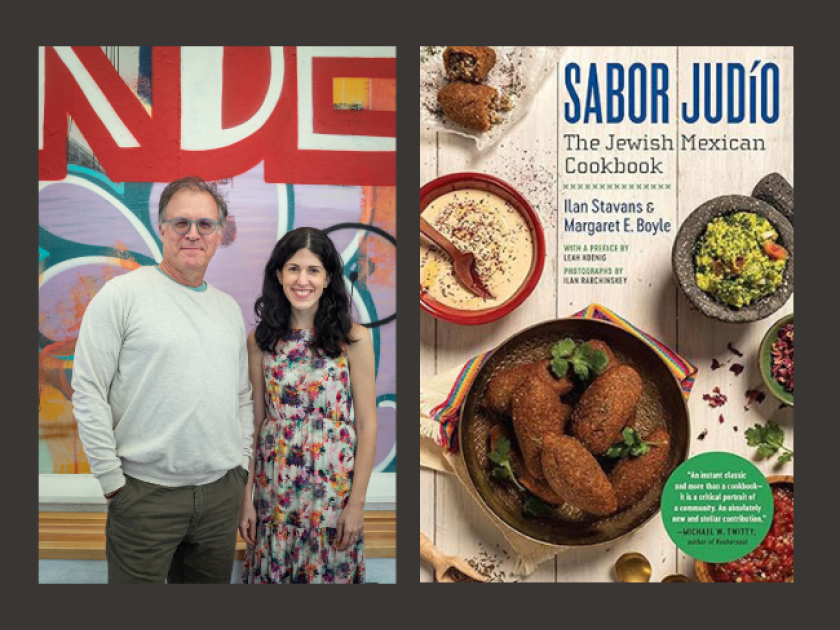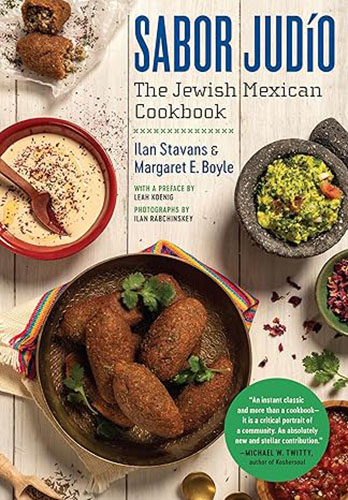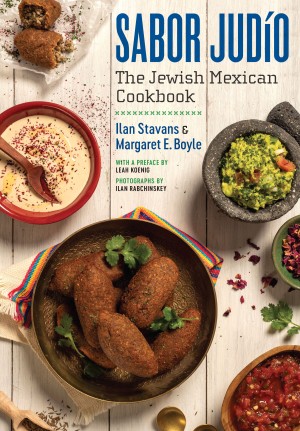
Photograph by Ilan Rabchinskey
Arroz con Leche (Ilan Stavans)
If there is a Jewish Mexican recipe that might be said to be my lifelong friend, it is this one. We had it for Sukkot, but honestly, I have such passion for it — and such a sweet tooth — that I’ve found ways for Sukkot to never start or end. The combination of white rice, milk and sweetened condensed milk, golden raisins, a cinnamon stick, grated lemon zest, and, on occasion, lemon peel, is a triumph. I recall coming back from the Idishe Schule and having it as a snack. My friends loved it. We would have a plate of it after playing fútbol in the nearby park or while watching the ever-popular primetime TV show Chespirito. But I especially remember savoring it in the sukkah under the stars (although, frankly, in Mexico City, as polluted as it is, the stars in the sky are more an aspiration that a reality). My mother prepared it regularly, and so did Inés López Caballero, the live-in help, who was an essential protagonist in our family life. Arroz con leche is the taste of my childhood.
Ilan’s family lived in Copilco, a neighborhood in the southern part of Mexico City, adjacent to the campus of UNAM (Universidad Nacional Autónoma de México), the largest public university in Latin America and one of the most respected. He credits this recipe with luring many of his high school friends, who lived in faraway parts of the city, to his house after class for a succulent portion of arroz con leche. Even though the dessert is a constant in Mexican cuisine, un no sé qué in the way it was made in Ilan’s home — lemon zest, a cinnamon stick, golden raisins — and how it made people experience myriad reactions. Although it has the texture of a pudding, the key is to allow the rice to preserve its integrity and not disintegrate.
Serves 4
Preparation time: 40 minutes
¾ cup short-grain white rice (such as bomba or arborio)
2 ½ cups water, plus more as needed
1 cinnamon stick
¾ cup whole milk
½ cup sweetened condensed milk
¼ cup golden raisins
1 ½ teaspoons vanilla extract
1 packed teaspoon grated lemon zest
Ground cinnamon, for dusting
1. Put the rice, water, and cinnamon stick in a medium saucepan set over medium high heat. Bring to a boil, then lower the heat to medium and cook, stirring occasionally (and more frequently as the liquid reduces, to prevent burning), until the rice is tender and the liquid has evaporated, 15 – 20 minutes.
2. Meanwhile, whisk together the whole milk, condensed milk, raisins, vanilla, and lemon zest in a medium-sized bowl. Pour the milk mixture into the saucepan and continue cooking, stirring often, until the mixture thickens, 5 – 10 minutes. (It will continue to thicken as it cools, so err on the soupy side.) Remove and discard the cinnamon stick.
3. Transfer to serving bowls and serve warm, dusted with ground cinnamon. Or let fully cool, then cover and refrigerate until chilled.
Brisket Tacos in Three-Chiles Salsa with Phyllis’s Rhubarb (Margaret E. Boyle)
Like many from LA, I want to eat tacos for every meal. Ideally, outdoors, in the sunshine, and with a crowd. Anat Turko’s brisket preparation brings together a marinade of pasillo, ancho, and guajillo chiles for a perfect blend of smoke and spice. For a sweet counterbalance, we’ve added my grandmother Phyllis’s rhubarb sauce. It’s easy to prepare batches of these tacos to feed a crowd. The recipe is perfect for a casual and festive Sukkot meal outdoors (under the sukkah with paper chains & papel picado). We should enjoy foods that remind us to slow down, nourish community, celebrate hospitality, and enjoy the changing seasons.

Photograph by Ilan Rabchinskey
This recipe fuses dishes prepared by two matriarchs in Ilan’s and Margaret’s families, Anat Nurko and Phyllis Poplawski. Anat prepares the three-chile marinade as learned from other women in her family, while Phyllis shares the rhubarb sauce joyfully passed down the generations and enjoyed as an accompaniment to all the varieties of brisket she prepares. Both women describe the kitchen as a place that brings them peace and connects them to earlier generations while emphasizing the joy they have in sharing and watching their children and grandchild prepare these dishes for their own families. When Margaret celebrated her first High Holidays away from home during college, Phyllis, her grandmother, shipped her rhubarb and brisket in the mail. Brisket became popular in Jewish cultures due to its affordability and is now a staple dish of most holiday meals. When preparing this recipe, consider wrapping the brisket and salsa in foil to simplify the cleaning process and enrich the flavor profile, as Margaret’s grandmother Phyllis recommends. The combination of tart rhubarb topping savory brisket is extraordinary, and the rhubarb sauce can be used as a complement to other preparations of brisket for festive meals.
Serves 8 – 10
Preparation time: 45 minutes, plus marinating
Cooking time: 4 hours
FOR THE BRISKET
3 cups water, plus more for covering the chiles
3 dried pasilla chiles
3 dried ancho chiles
3 dried guajillo chiles
4 medium plum tomatoes (about 1 pound), cored, seeds removed, and roughly chopped
½ medium white onion, peeled and roughly chopped
2 medium garlic cloves, peeled and roughly chopped
2 ½ teaspoons kosher salt, plus more as needed
1 brisket (4 – 5 pounds)
FOR THE RHUBARB SAUCE
2 large rhubarb stalks, cut into ½‑inch pieces (about 2 cups)
⅓ cup granulated sugar
¼ cup water
FOR SERVING
Small (6‑inch) corn tortillas, warmed
Chopped fresh cilantro
1. Place the pasilla, ancho, and guajillo chiles in a medium saucepan and cover with water by a couple of inches. (The chiles will float to the top.) Set the saucepan over high heat, bring to a boil, and continue boiling until the chiles are soft, about 15 minutes. Drain and let cool to the touch.
2. Wearing gloves, open each chile and remove the veins and seeds. Place the chile flesh and skin in a blender along with the tomatoes, onion, garlic, salt, and the 3 cups of water. Blend until smooth, then taste and add more salt, if needed.
3. Place the brisket in a large baking dish or roasting pan, cover with the chile salsa, then cover tightly with aluminum foil. Refrigerate for at least 2 hours or up to overnight.
4. Heat the oven to 325°F. Place the brisket in the oven and cook for 2 hours. Remove the baking dish, carefully flip the brisket over, and continue cooking until fork tender, about 2 hours. Remove from the oven and let rest for at least 30 minutes before slicing or shredding.
5. Meanwhile, make the rhubarb sauce: Combine the rhubarb, sugar, and water in a small saucepan set over medium heat. Bring to a boil, stirring often, and cook until the liquid thickens and the rhubarb is tender, 5 – 10 minutes. Remove from the heat and let cool slightly, then use an immersion blender to purée until smooth. Allow the sauce to cool completely.
6. To serve: Arrange the brisket in corn tortillas and top each taco with a little of the rhubarb sauce and chopped cilantro.
Ilan Stavans is the internationally known, New York Times bestselling Jewish Mexican scholar, cultural critic, essayist, translator, and Amherst College professor whose work, translated into twenty languages, has been adapted into film, theater, TV, radio, and children’s books.
Margaret Boyle is Director of Latin American, Caribbean and Latinx Studies at Bowdoin College, and Associate Professor of Romance Languages and Literatures. A Jewish-Mexican-American, her teaching and scholarship on early modern Hispanic culture and multilingualism today is award-winning nationally and internationally.




